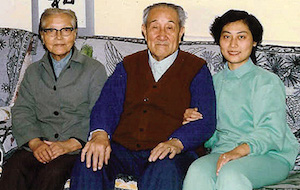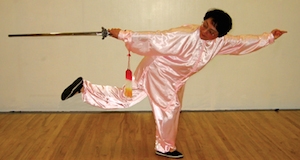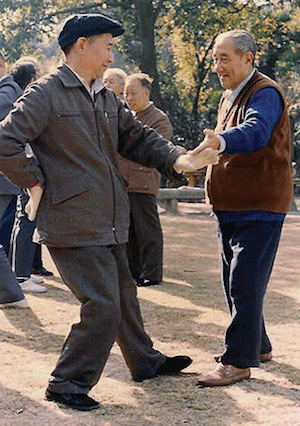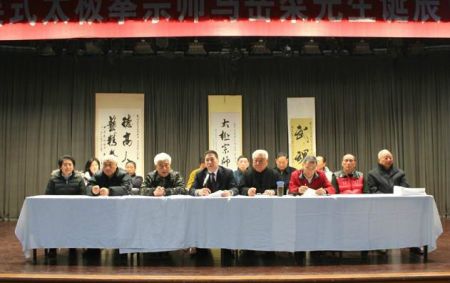A family perspective from their Grand-daughter Master Jin Ye
via an interview with Bar Stead

Wu Yinghua and her husband Ma Yueliang were regarded as the finest Wu Style instructors of their generation. Wu Yinghua was made “Worldwide Senior Instructor” (Grandmaster) of the Wu family style of Tai Chi Chuan from 1983 until her death in 1997. Ma Yueliang was made one of the “100 Best Wushu Masters of China” in his later years. Their grand-daughter, Master Jin Ye, continues the instruction of their authentic family style at her Yinghua Wu Style Tai Chi Chuan School in Huddersfield, West Yorkshire, England, named in honour of her Grand-mother. In this interview she provides a fascinating “insider” family perspective into aspects of their lives as Tai Chi Chuan instructors.
Wu Yinghua first started teaching tai chi as an assistant to her father Wu Jianquan at the age of 17 in the Beijing Physical Culture Research Institute. She mostly taught other women including the wives and daughters of several bankers in Beijing. In 1921 amid unrest in Beijing the bankers moved to the safety and more cosmopolitan Shanghai. Wu Yinghua was invited to join them to continue teaching tai chi, which she did initially living with the bankers families in Shanghai.
Wu Yinghua suggested that her father follow her to the safety of Shanghai. He moved in 1926 and opened the Shanghai Wu style taijiquan association in 1933 on the 9th floor of the YMCA building in Shanghai.
Ma Yueliang a senior disciple of Wu Jianquan moved with him to Shanghai and married Wu Yinghua in 1930. Jin Ye, their second grandchild was born in 1961, to their first daughter Ma Jiangchun.
Traditional Wu Style Tai Chi Chuan Interview with Master Jin Ye
Please tell me about your introduction to taiji and about your “taiji family”
Wu Yinghua, my Grand-mother, took a personal interest in teaching me Tai Chi from a very early age, about 10 years old, a similar age to when she started. They thought I was good enough to instruct by the time I was 22 years old when I started teaching Wu Style classes in Shanghai. Ma Yueliang also instructed me, along with my uncles: Ma Jiangbao (who is Chairman of the European Association for Traditional Wu Taichi Chuan), Ma Hailong (President of the Shanghai Wu Style Academy) and Ma Jiangling, (also of the Shanghai Academy). Indeed it was Ma Yueliang who originally certified me as one of his qualified instructors, many years ago. I still have the original certificate, signed by him, which is one of my prized reminders of them.
What were your grandparents like as instructors?
They were both completely dedicated to teaching the Wu Style and spent many, many, hours instructing. Wu Yinghua was patient and encouraging. Ma Yueliang was more typical of a male teacher of that period. He required very precise accuracy in the movements (Chih in Chinese) with much repetition. Both were very sympathetic and supportive towards their students. They both believed passionately in the Tai Chi qualities of Calmness, Composure (Qie), Humility and Conscientiousness (Jing) which they emphasised in their classic book, “Wu Style Taichichuan – forms, concepts and applications of the original style”. I still refer to an original Chinese copy. They also, of course, developed the modern versions of the Wu Style Short Form (30 movement) – as requested by the Chinese government – and Long Form in the 1950’s, which we still teach today.
Given the attitudes to women in China how do you think Wu Yinghua managed in such a male dominated arena?
 Wu Yinghua was highly skilled in the art of taijiquan, and it is true that normally men would not want to be seen to be taught by a woman, but Wu Jianquan was said to have realised this and said “A woman does not always have to follow a man.” This would have been a very enlightened statement in early 20th century China. It is a shame that in terms of recognition there are still far fewer women than men viewed as masters. Wu Yinghua did not practice tui shou (push hands) outside of the family for these reasons.
Wu Yinghua was highly skilled in the art of taijiquan, and it is true that normally men would not want to be seen to be taught by a woman, but Wu Jianquan was said to have realised this and said “A woman does not always have to follow a man.” This would have been a very enlightened statement in early 20th century China. It is a shame that in terms of recognition there are still far fewer women than men viewed as masters. Wu Yinghua did not practice tui shou (push hands) outside of the family for these reasons.
Gerda Geddes (who was taught in Shanghai in the late 40s, early 50s.) stated that very few women were taught taiji, and because of etiquette physical contact between men and women was not possible, therefore she wasn’t taught tui shuo, and physical touch on corrections was not done either. Was this the case with Wu Yin Hua?
It is true that it would have been difficult for ‘external’ women to get push hands training for a variety of reasons, including etiquette, and simply that some male teachers would not want to teach a woman. Certainly this was not a problem for Wu Yinghua, although she did choose not to push with people outside of the family.
Are you able to elaborate more on how tui shuo was taught in the family?
 In some ways training for family members was harder than for paying students; there was no ‘formal’ training, a family member would start learning by passively watching and listening, only after some time if they started showing potential would any attention be shown to them. Times were quite hard and Ma Yueliang and Wu Yinghua had a large family to look after during both World War II and the Chinese Civil war, so there were no set times for training, sessions would be ‘fitted in’ when and where they could. The parents would also often be less tolerant and more severe of their own offspring than that of a paying student. It is very similar to family life of today; I was lucky because I was a grandchild, my grandparents would be much more tolerant and patient with me than with their own children.
In some ways training for family members was harder than for paying students; there was no ‘formal’ training, a family member would start learning by passively watching and listening, only after some time if they started showing potential would any attention be shown to them. Times were quite hard and Ma Yueliang and Wu Yinghua had a large family to look after during both World War II and the Chinese Civil war, so there were no set times for training, sessions would be ‘fitted in’ when and where they could. The parents would also often be less tolerant and more severe of their own offspring than that of a paying student. It is very similar to family life of today; I was lucky because I was a grandchild, my grandparents would be much more tolerant and patient with me than with their own children.
All students would have to know and be proficient in the form (at that time this would have been the traditional long form as the shorter forms had not yet been created) before they would be taught any push hands. Knowing the form is all that is needed for good push hands; a soft upper body, control from the waist and a firm root. I also remember my grandmother holding sword stances for long periods at a time, in the heat of the sun in their courtyard. In China this practice was enough.
In the West people seem to need more; they want verbal explanations, they need to visualize things more. I try to bring some of this to my own teaching but it is difficult because the art is so much a sensory one.
Why are there relatively few photos or movies of them?
There are, I believe, both cultural and practical reasons for this, although it is a big disappointment to the family that these two great instructors were not recorded more. At that period there was not a culture in China of photographing their own work as either instructors or during demonstrations.
 To them, the direct one-to-one instruction was the important part. There was also the practical aspect that photography, especially cine, was not generally available to ordinary people, especially in the period prior to, and during, the Cultural Revolution, when they were at their peak as instructors. Most of the photos and cine available today are of them giving demonstrations, often informally, in their 70s and 80s.
To them, the direct one-to-one instruction was the important part. There was also the practical aspect that photography, especially cine, was not generally available to ordinary people, especially in the period prior to, and during, the Cultural Revolution, when they were at their peak as instructors. Most of the photos and cine available today are of them giving demonstrations, often informally, in their 70s and 80s.
Were they also skilled instructors in other aspects of Wu Style, such as weapons forms?
Very definitely yes. Wu Yinghua was an outstanding instructor in the various Sword Forms. She personally taught me all of the Wu Style sword forms (#1 The Heaven and Earth Sword; #2 The seven Stars Sword; #3 the “linked chain and ring” Sword; the Double Handed Sword Form; and the Two Person Sword form, plus the Sabre Form). Unfortunately most of these sword forms are not generally taught today, which is why I have tried to model myself on her and keep her memory alive, by offering instruction in all these sword forms at my school. One of my Senior Disciples, Bar, won a Silver Medal in the Jian at the 2009 UK open tai chi championship.
 I also remember Ma Yueliang giving a demonstration of the Sword Form #1 at the opening ceremony of the First International Tai Chi Chuan Competition in Wuhan, China, when he was 83 years old. He was also an expert with the Sabre and also taught both of the Spear Forms, as well as being an outstanding instructor of Pushing Hands. My Uncle, Ma Jiangbao, and myself continue to teach his style of Pushing Hands (13 movements).
I also remember Ma Yueliang giving a demonstration of the Sword Form #1 at the opening ceremony of the First International Tai Chi Chuan Competition in Wuhan, China, when he was 83 years old. He was also an expert with the Sabre and also taught both of the Spear Forms, as well as being an outstanding instructor of Pushing Hands. My Uncle, Ma Jiangbao, and myself continue to teach his style of Pushing Hands (13 movements).
The Wu Style Fast Form was reviewed by Michael Acton in Issue 30. What are your thoughts?
I thought it was an excellent, well researched and balanced article on the Wu Style Kuai Quan or Fast Form. Unfortunately I don’t think that Michael and I have met, but I do remember seeing his instructor, Master Li Liqun, at my Grandparents house in Shanghai, when I was a young girl. When Wu Yinghua and Ma Yueliang developed the Slow Short Form, originally in the 1950s at a similar time when the Yang 24 short form was developed, they followed the same movement sequence of the Long Form, but eliminated most of the repetitions and one or two of the more difficult movements, to make it more accessible for beginners. The Fast Form, however, continues unchanged from that taught by Ma Yueliang, and he always maintained that he taught it unchanged from how he learnt it from Wu Jianquan. The sequence of movements is essentially the same in both the Fast Form and the Long Form, as are the movement names, but some of the movements are, of course, carried out very differently. I have taught it only to a small number of my students, although in China it would have originally been taught to the youthful practitioners of taijiquan, who may have later gone on to learn the slow forms!
 How do you teach Wu Yinghua and Ma Yueliang’s authentic Wu Style Tai Chi Chuan?
How do you teach Wu Yinghua and Ma Yueliang’s authentic Wu Style Tai Chi Chuan?
I don’t adopt a rigid teaching regime, but I do use what I believe is a sensible progression of increasing difficulty. I want to make tai chi accessible for people so I will teach people to their ability and I try to teach things that are of interest to my students. My first classes in this country were for ladies only and we tended to concentrate on the short form, but as the classes and mix of people have expanded there has been a lot more interest in the sword forms and other aspects of taiqiquan.
So you don’t believe that there should be a set syllabus and practice of all aspects of taijiquan?
Obviously to become complete in taijiquan one should study and practice all aspects, but I believe that any tai chi is better than none and students will come to want to study all aspects if that is their path.
There are some clips of you performing a fan form on your web site. Was this an original Wu style form?
No. The Wu family originating from Northern China did not originally use the fan and so didn’t have a fan form, but several of my students had been asking to perform a fan form for some time. I could have taught them a Yang style form but I thought it would be nice to have a fan form within the Wu set. I regard it primarily as a weapon and form for ladies and as I follow the female lineage from Wu Yinghua I decided I would create one. (Jin Ye is the daughter of Wu Yinghua and Ma Yueliang’s eldest daughter, Ma Jiangchun.) The form displays the beauty of the fan while maintaining the Wu style principles in the movements.
Being connected to this important lineage do you feel a duty to pass it on?
Yes, I want to pass on good quality tai chi. For some students it is enough that they learn the short form, and for them it may simply be an exercise for good health. For other students, especially those that want to teach the art, it is important to me that they have very precise movements, so that they too can share the art without it losing its meaning. Wu Jianquan said that of all his children Wu Yinghua performed the form most precisely, I hope I can pass this precision on to willing learners.
What does she feel about the state of the taiji world today and do you have any views on how it will develop in the future?
It is good that more people (especially in the West) are at least aware of tai chi, but it is a shame that it still tends to attract the older generations. This is generally true of tai chi in China too. I think that the popularity of tai chi will grow, but that its greatest benefit would be derived from people starting to practice earlier in life; while they are still strong and their bones are still dense. Tai Chi can then maintain their health and strength, rather than having to start from a position of relative weakness.
How do you keep the Wu style taijiquan alive?
As a member of the Jianquan Taichi Association of Shanghai, I am being contacted by my Association regularly for all important matters. I was invited to attend the 110th anniversary, as a committee member, chairing the meeting, not only as the granddaughter of Ma Yueliang and Wu Yinghua, but also as 5th generation of Wu Style master. Together with three of Ma Yueliangs’s sons (my uncles), I met with lots of Ma Yueliang’s direct disciples and their students nationally, whom I have known for over 40 years.
During the demonstration session, as a host of the meeting, I was also requested by the new chairman Ma Wenzhao (my cousin) to perform the second Wu style double edged sword form (seven stars), which I learned direct from Wu Yinghua, this reminded people of my grandmother dearly.

Finally, have you an anecdote which sums up your Grandparents approach to Tai Chi instruction?
As well as the technical aspects of teaching Wu Style Tai Chi Chuan, both Wu Yinghua and Ma Yueliang emphasised the personal qualities appropriate to being an instructor. When Ma Yueliang was honoured by being made one of the 100 Best Wushu Masters of China, also known as The Living Legends, he was asked the following question by one of the reporters. We used to refer to you as Shi Fu (Instructor), then as Master and many people often call you Grandmaster. Now that you have received this further honour, how should we address you now? Ma Yueliang thought briefly and replied all my life I have regarded myself as a student of the Wu Style, so please refer to me as “student Ma Yueliang”. Humility was a key part of their overall philosophy of Tai Chi Chuan. Similarly my own students sometimes refer to me as Shi Fu, sometimes as Master, but generally they just address me by my name, Jin, which is as it should be. I believe that my Grandparents would approve.
The interview was conducted by Jin Ye’s student Bar Stead with some additional questions by Ronnie Robinson of the UK’s Tai Chji Chuan magazine.
Master Ye Jin teaches in Huddersfield and can be contacted via her school’s website www.yinghua-wu-style.org and Bar teaches in Bradford and can be contacted via his school’s website www.ridethetiger.org .
Ye Jin instructs the authentic Wu Style of Wu Yinghua and Ma Yueliang and offers instruction to beginners and advanced students, in the Short and Long Forms, the Fast Form, various Sword Forms, Spear, Sabre and Pushing Hands, together with Chi Kung. She also instructs Single and Double-handed Fan Forms which she has developed herself.
